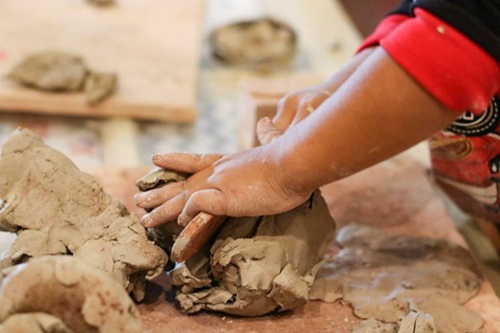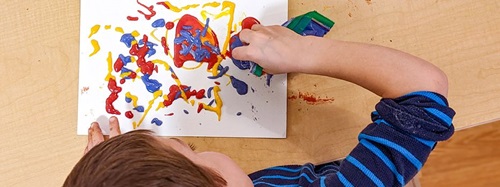Exploring Sand Play
| February 2014Sand and water hold a tremendous attraction for young children, but as time for play is increasingly threatened by standards and curriculum driven activities, how can teachers validate the educational value and necessity of sand in the classroom?
Young children are active learners. Jean Piaget, a Swiss developmental psychologist, held that children draw on direct physical and social experiences as well as culturally transmitted knowledge to construct their own understandings of the world around them. Children start life taking in information through all their senses. Children naturally love playing with sand and teachers can capitalize on this natural affinity by bringing it into the classroom and incorporating it into their curriculums. Because of its sensory nature, sand play is an excellent medium for exploration and discovery and provides opportunities to integrate STEM education into preschool classrooms. STEM stands for Science, Technologies, Engineering, and Math all of which can be incorporated into sand exploration.
Encouraging Exploration. Young children are naturally curious and love to investigate, question, and hypothesize. Teachers need to provide young children with the time, the materials and the environment to encourage their exploration and discovery. It’s important not to correct every error, but allow them to learn from their own mistakes. Remember that Piaget said that for young children to learn they must construct their own knowledge.
Process Rather than Product. Through play children are laying the foundation of fundamental life skills. For example, it takes young children a long time to construct the concepts of mathematics that are basic to science by discovering and practicing these mathematical relationships for themselves. Using sand play allows them to discover these mathematical principles, and then practice by playing allows them to construct this new knowledge. This active exploration should come mostly from children’s own ideas. Young children can’t internalize mathematical concepts on the basis of a single experience, but on experiences repeated over and over again in different ways and with different materials. The materials used in sand play should stress process rather than product.
Spatial Relationships. To help children develop spatial relationships encourage them to describe what they are doing. Have them fill empty containers with sand and talk about big, bigger, and biggest. Ask them question about which is smaller than or larger than. Wet sand is a perfect material for exploring spatial relationships and shapes. While they are playing ask them to make a row of two or three sand towers from small to large. Give them plenty of time to arrange them in a sequence from smallest to largest. Above all, don’t tell them what to do, allow children the time to discover it by themselves.
Mathematical Relationships. To encourage the development of mathematical relationships support children’s efforts to count even if they do it incorrectly. For young children it is difficult to do two things at the same time, such as pouring sand in a pail and counting, so give them lots of time to practice. When they are interested in “how much,” some will discover that more sand means more weight and more mass. Hopefully they will discover that a full pail of sand may be harder to hold, while an empty pail is much easier to hold. Ask questions that stimulate children to explore materials in a different way.
Educating the Whole Child. Experiences with sand, as with many other manipuatives, are not confined to particular discipline areas but can enrich and add depth to all areas of learning. The following activities demonstrate how sand play can support child development in four major domains of education by stimulating their interest and curiosity.
- Language and Literacy Domain. The goal of this domain is for children to learn and develop their vocabulary and increase their ability of early speech and comprehension.
- Writing a Sand Play Experience Chart
- After an interesting sand play activity, suggest that the sand play activity be written about on an Experience Chart. Have the children tell about what happened and use their names when writing it down. Make Experience Charts using words, numbers, and pictures. Point out words and symbols in the environment, and make signs that fit in with the children’s play. The purpose of an Experience Chart is to have children recognize that spoken words can be written down. Charts should be designed with the children’s active involvement. Make pockets with vocabulary words. Parts that move, pictures, or pieces that can be added or removed can add extra interest. The STEM area of Technology can be added by having children record, using both audio and video, their experience.
- Physical Domain. Increases large and small movement skills including spatial relationships, gross and fine motor skills and body awareness through exploration.
- Making Sand by Weathering Rocks
- The act of rubbing together of rocks and shells as wind and water grind them against one another is called weathering. Have the children draw a design on paper with white glue. Then have them hold two rocks and rub them together to make sand over the glue design and the sand will stick to the glue to make a sand drawing. To make colored sand use dry tempera paint mixed with the sand or have the children rub different colored chalk against sand in pie plates to create different colored sands. These can be layered in baby food jars to make interesting gifts for parents. The STEM area of Science is strongly represented by the children’s act of weathering the stones.
- Cognitive Domain. Increases critical thinking skills including memory and problem solving, planning skills, academic attitudes, creativity and divergent thinking skills.
- Comparing Sieves and Funnels
- There are many ways for young children to explore using simple tools. Have them observe the size of the openings in sieves and funnels. Compare large ones and small ones and explore which catches the most stones and shells and which lets sand through the fastest. Help children develop critical thinking skills by experimenting with the funnels by trying to predict whether the big or small funnel will let dry sand through the fastest. Hold a funnel race to determine the winner. The STEM area of Math is incorporated by having the children determine “how much” each of the tools allow sand, stones and shells to pass.
- Social/Emotional Domains . Increases sensitivity to others through cooperative activities, learning social skills, to handle exclusion and dominance, and share ideas with others.
- Building a Sand City
- Encourage children to work together to make a sand city. Have them bring in square, triangular, circular (juice or yogurt containers), and rectangular containers to work with. Let some of the children make buildings and some of them make roads around the buildings. Talk about the shapes of the buildings and their size. Ask the children to use a variety of containers to add a three dimensional quality to their sand city. Add cars, people, animals, rocks, and twigs to make trees to make their city more realistic. Include various forms of transportation such as railroad, airports and bus stations. Have them make traffic signs (stop, yield, curve, etc.) for their sand city. The STEM area of Engineering is very strongly represented by having the children put buildings and roads in their sand city.









